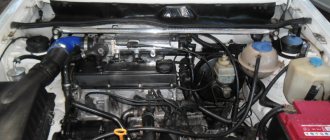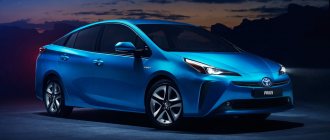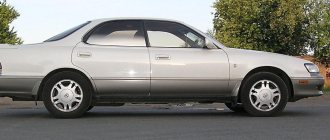Prius
Sales of the first-generation four-door Prius sedan started in the domestic market in December 1997. The car was equipped with a 1.5 liter petrol engine and a 30 kW electric motor.
In 2000, after restyling, the performance of the hybrid power plant was improved. At the same time, the first generation Prius was introduced to the European and American markets.
The second Prius, already in a hatchback body, went on sale in 2003. The electric motor of its hybrid unit has become much more powerful, so the gasoline engine starts working less often, which has a positive effect on fuel efficiency.
Second generation Toyota Prius with the famous triangular profile
The third Prius appeared on the domestic market in May 2009. Its hybrid powertrain was 90% new, and the specially developed 1.8-liter engine mainly operated at lower speeds.
Based on the new TNGA platform, the fourth generation Prius became available in Japan at the end of 2015. Externally, the car was different from its predecessors. The power unit remains the same, but has become more efficient. For the first time, but only in the domestic market, an all-wheel drive version of the Prius was offered.
Engines installed on the classic Prius:
- 1NZ-FXE (1.5 l; 58, 70, 72, 76, 77, 78 hp);
- 2ZR-FXE (1.8 l; 98, 99 hp).
For those interested, a full description of what a Prius is
Description
The Prius has a gasoline engine and two electric motor generators, as well as a low-capacity 6.5 Ah battery (often called a high-voltage battery, HVB). The electric motor can also work as a generator, converting kinetic energy into electricity and recharging the battery. In this case, electricity can be generated both due to the operation of the gasoline engine and due to the braking of the car (regenerative braking system). The motors can work either separately or together. The gasoline engine is an Atkinson engine; such engines are economical, but have relatively low power. The operation of all engines is controlled by an on-board computer.
The Prius is easily recognizable by its streamlined shape. The aerodynamic drag coefficient is only 0.26. The air conditioner runs directly from the battery, regardless of the engines.
The cabin is equipped with a touch screen showing engine operation, battery fullness and other parameters. The display allows you to control the audio system and air conditioning, but not the car. Gears (forward, neutral, reverse, power) are switched not by the gearbox, but by a joystick located near the steering wheel and a button next to it (for parking). The “handbrake” is made in the form of a pedal under the driver’s left foot. The speed is shown by a green digital indicator. The car is opened with an electronic ignition key; if it malfunctions, you can get into the salon (but not drive) using a mechanical key. The car is turned on by pressing the Power button while the brake is pressed.
The Prius is highly economical for several reasons:
The efficiency of any gasoline engine is not a constant value, but depends on power. Thanks to the ability to both add power using an electric motor and spend part of the power on charging the battery, and also (at low speeds) turn off the gasoline engine altogether and drive only using electricity, it is possible to optimize engine performance.
When stopping in traffic jams, at traffic lights, etc., the engine turns off. In other cars, it idles, consuming gasoline. In long traffic jams, the life support system (headlights, on-board computer, audio system, power brakes and steering) “eat up” the battery charge and the engine starts to recharge the VVB, but this is still much more economical than “spinning” a 2-liter engine (the approximate equivalent of a power plant Prius).
The Atkinson engine is economical in itself. Its low power is a tolerable drawback, since additional power can be provided by an electric motor.
When braking and braking (on a steep descent, for example), energy is stored in the battery thanks to regenerative braking.
Low aerodynamic drag reduces fuel consumption, especially at high speeds or in strong headwinds.
Some models are equipped with an EV button that activates electric vehicle mode. In this mode, the car can smoothly accelerate (up to 57 km/h) and brake, and can show high efficiency on open highways with small elevation changes. An additional advantage is the ability to drive into a poorly ventilated garage and not be afraid of being poisoned by exhaust fumes. However, in this mode, during the cold season, the possibilities of heating the interior are limited - all modern cars heat the interior by removing heat from the cooling system, which cools down in several tens of minutes when the engine is not running.
[edit] Advantages High efficiency, as a result - savings on gasoline costs and the need to stop at a gas station less often[3].
Low level of air pollution. This is partly a consequence of efficiency (the less fuel is burned, the less harmful emissions), and partly - turning off the engine at stops, when gases that are especially harmful to human health enter the atmosphere. Compared to a traditional car, the Prius emits 85% less unburned hydrocarbons CnHm and nitrogen oxides NOx [source unspecified 409 days].
Low noise level for several reasons:
During stops, the engine turns off
Together with the gasoline engine, and sometimes instead of it, a quieter electric motor operates
Excellent dynamics:
the traction motor always produces maximum torque
absence of a gearbox as such (planetary gear is used)
High level of safety for driver and passengers for several reasons:
Two independent braking systems - regenerative and friction
The machine is heavy (1240 kg)
High crash test results for driver and passengers[4]
Electronic ignition key.
[edit] Disadvantages Higher price than conventional cars of the same class. In many countries, however, the high price is partially offset by tax incentives. In addition, the difference in prices is partially or fully compensated by gasoline savings.
There is an opinion that the quietness of the car can be dangerous for blind or inattentive pedestrians.
It is not recommended to leave the car without driving for more than 3 months due to possible battery discharge.[5]
A small number of repair specialists and car services repairing hybrid cars.
At subzero temperatures, the benefits of the hybrid drive may be lost, since the internal combustion engine is almost always running, generating energy to heat the cabin if it is turned on.
High dynamics are only achievable at low speeds, since at high speeds the entire load falls on the low-power internal combustion engine.
[edit] Criticism Some believe that in the future there will be a problem of recycling used batteries, just as there is already a problem of their “dirty” production. However, Toyota and Honda have committed to recycling used batteries; Moreover, they not only accept used batteries, but also pay $200 for each [5].
In Top gear, Jeremy Clarkson criticized the Prius for not being as economical and environmentally friendly, since the supply and recycling of all components of the car, in particular the batteries, leaves too much of an environmental footprint[6]. On the track, the BMW M3 and Toyota Prius made 10 laps at the same time at a speed of 160 km/h. The BMW M3 followed the Toyota Prius. The BMW was more economical with a mileage of 19.4 miles per gallon of gasoline, while the Prius' mileage was 17.2 miles per gallon of gasoline.
So if you want an economical car, buy a BMW M3? - No... Don't change the car, change your driving style.
Original text (English) [show]
If you want an economical car, buy a BMW M3? - No... Don't change the car, change your driving style.
[edit] Design features When braking, it automatically recharges the battery (regenerative braking).
During dynamic acceleration, both engines combine their efforts - Hybrid Synergy Drive.
The on-board computer (32-bit processor) maintains the optimal operating mode of the gasoline engine (Atkinson cycle) and the optimal battery charge level (Panasonic, NiMH, 8 years warranty).
The start-stop of the gasoline engine is fully automated, switching between the “Drive” and “Parking” modes is done using a joystick on the dashboard (Drive-by-Wire).
Prius a/v
The Prius α (Alpha) station wagon was introduced to the domestic market in the spring of 2011. The standard battery was replaced with a more compact lithium-ion one. The same car, but under the name Prius v, went on sale in the United States at the end of that year, and in the summer of the following year, 2012, it was introduced in Europe as Prius+.
Seven-seat station wagon Toyota Prius v
Engines installed on Prius "alpha":
- 2ZR-FXE (1.8 l; 99 hp).
Engines installed on the Prius V:
- 2ZR-FXE (1.8 l; 98 hp).
Test drive ToyotaPrius 1.8
The total power of the Toyota Prius hybrid powertrain is about 136 hp, which adds up to 99 hp. 1.8-liter gasoline engine and 79 hp. electric motor. Complex arithmetic, isn't it?
The morning on which I had to pick up a hybrid Prius from the office of the Russian representative office of Toyota turned out to be cloudy. I’m standing in the parking lot, waiting for the treasured key to be brought to me. Corporate ethics forces employees to park only Toyota and Lexus cars in the parking lot in front of the building; all others are hidden in the parking lot behind. Here are the new Toyota Land Cruiser Prado, the cheerful iQ kids, and premium Lexuses. The snow-white Prius stands out against the background of all the others with its unusual drop-shaped silhouette.
The appearance is exactly like in the films of the future 10 years ago, in which cars with bizarre shapes seem to hover over the streets of modern megacities, where, along with people, the world is controlled by robots with advanced intelligence, which at any cost must take over the world and destroy humanity.
For some reason, the Toyota Prius evokes just such associations in me. Complex front optics with two LED lenses, a humpbacked roof, Toyota brand badges with a blue halo indicating the complex hybrid filling of this road device, fancy alloy wheels made to improve air resistance - the exterior of the Prius can be described ad infinitum. However, when developing this car, Japanese engineers primarily thought not about high fashion and automotive catwalks, but about aerodynamic characteristics. After all, the philosophy of the hybrid drive is to protect the environment and save fuel. It must be said that the Toyota team coped well with this task: the aerodynamic drag coefficient of the Toyota Prius is 0.25 Cx.
Inside, the theme of the future is continued in the electronic instrument cluster, a plump steering wheel with a hewn lower platform, a “floating” center console and a delicately executed transmission selector. Everything is modest, not pretentious, but quite functional and modern. The front seats have a tolerable profile, but due to the very slippery leather trim, passengers are literally thrown out of the seat when turning. When turning, you have to push hard into the left foot rest and hold on to the plump steering wheel.
Like a real car of the future, the Toyota Prius has a couple of gadgets in its arsenal for “entertainment”. The first is a projection of speed and navigation system data onto the windshield. It seems to be a common thing, but here Toyota has gone further: using special keys, the picture can be adjusted in height and brightness.
Also worth noting is the possibility of automatic parking. And the Prius surprised me again! It can park not only parallel, but also perpendicular. True, the procedure is tedious, and parking conditions must be ideal.
The rear of the Toyota Prius is spacious and comfortable - there is virtually no central tunnel. The only thing that upsets me is the same notorious slippery skin. The trunk volume is 445 liters. A little? But under the floor they managed to place a full-size spare tire, and even a set of batteries that power the electrical component of the hybrid drive.
The total power of the Toyota Prius hybrid powertrain is about 136 hp, which adds up to 99 hp. 1.8-liter gasoline engine and 79 hp. electric motor. Complex arithmetic, isn't it? The thing is that out of the “ideal” 178 hp. you need to subtract the part of the power that goes into recharging the electric motor, which is done by the generator and a set of batteries.
The filigree transmission selector, located on the “floating” console, is responsible only for driving modes; “parking” is activated by a separate button. Nearby there are three more keys responsible for operating modes. The first EV only activates electric propulsion. As a result, the Prius turns into a real “trolley car”. But there are some limitations here: don’t press the gas too hard, don’t accelerate more than 35 km/h. And the battery charge in EV mode melts before our eyes. The economical Eco mode is more suitable for jostling in traffic jams. Responses to the accelerator pedal are sluggish, but fuel consumption is appropriate. After pressing the PWR key, the Toyota Hybrid transforms. Gas response becomes faster and acceleration becomes more dynamic.
The Prius steers synthetically. At speed, excessive steering is often required, the need for which increases with a strong crosswind, which tends to push the hatchback into the next lane. When cornering, the clearly unnatural force on the steering wheel is annoying, as a result of which the driver has to play a guessing game when choosing the right trajectory. But in the city, the Toyota hybrid is at ease. The “short” steering wheel, good maneuverability and ease of control combine perfectly with the urban landscape of a large metropolis.
Now about the main thing, about efficiency. After all, whatever one may say, the hybrid drive appeared precisely with the aim of reducing the amount of harmful emissions into the atmosphere, which is directly dependent on fuel consumption. The Prius didn't disappoint here. According to the on-board electronics, the average fuel consumption was about 5 liters per 100 km. Moreover, the phenomenon of the hybrid is that both in a traffic jam and on the highway, if this figure has deviations, it is literally by a couple of tenths. After all, in a traffic jam, the electric motor takes on a large load, and on the highway, the gasoline engine, according to the laws of the genre, is responsible for saving money. Of course, if you wish, you can increase fuel consumption on a Prius to serious heights, but this is not what the car was created for.
The cost of Toyota Prius from official dealers is 1,249,000 rubles. The amount is considerable. For this money, most Russians will prefer a car of a higher class. However, gradually in our country people are beginning to think about efficiency, paying more and more attention to modern diesel engines. Maybe someday it will be the turn of hybrids. Only for this purpose a consumption of 5 liters per 100 km is not enough. For owners of hybrid cars, it is necessary to introduce a preferential transport tax and make discounts on fuel. And only then can dreams of a green planet with clean air and crystal rivers become a little more real. In the meantime, the technologically advanced Prius is forced to coexist on the road with 20-year-old dilapidated trucks, which have a brand new inspection ticket on the window, and smoke mixed with motor oil pours out of the exhaust pipe...
Text: Ruslan Galimov
Prius C
In the spring of 2012, a compact hatchback called the Prius C (aka Aqua) was introduced in North America. The car had the lowest fuel consumption in the world at that time. The new product was equipped with a 1.5 liter gasoline engine and had a very compact battery.
Compact hatch Toyota Prius c
Engines installed on the Prius "C":
- 1NZ-FXE (5 l; 73 hp).
Prius PHV/Prime
In the summer of 2007, Toyota presented to the public a prototype called the Prius PHV (Plug-in Hybrid Vechicle), created on the basis of the classic second-generation model. The car received an enlarged battery, charged from an external power supply.
At the beginning of 2012, limited quantities of the “rechargeable hybrid” began to be offered in Toyota’s key markets: Japan, North America and Europe. The car could travel about 25 kilometers on electric power alone and was fully charged in just 1.5 hours.
Rechargeable Toyota Prius PHV 2021 model year
An updated version of the Prius PHV, based on the classic fourth-generation model but with twice the lithium-ion battery, was introduced in February 2021. In electric mode, the new battery allowed a range of up to 68 kilometers. It was possible to bring its charge to the maximum from a household electrical outlet in the range from 2 to 14 hours. In North America, the Prius PHV is sold as the Prius Prime.
Engines installed on the Prius PHV:
- 2ZR-FXE (1.8 l, 99 hp).
Engines installed on Prius Prime:
- 2ZR-FXE (8 l, 95 hp).
Description of the operating modes of the hybrid power plant
Charging Prius Prime
In this section, we will look at how the Toyota Prius hybrid installation works in various modes. Among them:
the beginning of movement with the start of the internal combustion engine;
electric start and high speed driving;
starting 2ZR-FXE on the go;
reverse.
Start of movement with starting of the internal combustion engine
Prius 10
This mode is used when the battery charge is insufficient for starting a Toyota Prius. In this case, the hybrid works as follows:
- Due to the action of generator motor No. 1, the planetary mechanism rotates, which starts the internal combustion engine;
- The internal combustion power unit begins to accelerate motor-generator No. 1, which is accompanied by the latter switching to generator mode. Next, the required amount of electrical energy is generated to charge the battery and ensure the operation of the second motor generator;
- 2ZR-FXE can work exclusively to ensure the operation of the first motor generator and maintain the required voltage in the Toyota Prius electrical network.
Electric start and high speed driving
The electric traction of the Toyota Prius hybrid installation operates when the car starts from a standstill in the following sequence:
- The ride begins with the gasoline unit turned off;
- Electric motor No. 2 drives the wheels and electric motor No. 1 through a planetary gear train. This process is provided by the stored energy of the battery. In this case, the voltage is converted from constant to alternating.
To ensure that the Prius moves at high speed when the permissible speed of electric motor No. 1 is reached, the following principle is used:
- Motor-generator No. 2 switches through gears to rotate the first one with a multiplicity of 2.6;
- This ensures a reduction in the rotation speed of electric motor No. 1 by 2.6 times relative to the second. The maximum permissible speed for the first electric motor is six thousand, reached at a speed of 64 km/h.
Starting the internal combustion engine on the go
The principle of operation of the Toyota Prius hybrid with the launch of 2ZR-FXE while driving is as follows:
- The gasoline power unit is turned on when the generator motor No. 1 stops, which is slowed down by changing the direction of the electromagnetic flow in the opposite direction relative to the rotation of the rotor. In this case, the engine starts due to the removal of rotating torque from the wheels of the car;
- After the internal combustion engine gains speed, the directions of rotation of all units of the hybrid installation coincide. If the number of revolutions is equal, there will be a uniform distribution of forces on wheel rotation;
- With an increase in engine speed, in comparison with electric motor No. 2, there will be an increase in the electricity generated by motor generator No. 1. It is distributed to charge the battery and maintain further movement by transferring energy to electric motor No. 2.
From the indicated operating mode of the hybrid, it can be clearly seen that the motor is not directly connected to the wheel drive. It transfers energy to the rotation of the wheels only when the number of revolutions of the wheels and the engine axis is equal. The basic task of a gasoline unit is to operate an electric generator. This allows you to maintain the required battery capacity.
Reverse
Prius Prime
Motor-generator No. 1 is responsible for driving a Toyota Prius in reverse. At the moment the internal combustion unit is switched off, the first electric motor switches to propulsion mode. This is accompanied by opposite rotation relative to motor-generator No. 2. In this case, the planetary axis is fixed in place, and the torque from the first electric motor is transmitted to the second, through the gear transmission of the planetary mechanism. Electric motor No. 2 rotates in the opposite direction, which is accompanied by the vehicle moving in reverse.
When the gasoline unit is running, to move in reverse, it is necessary to increase the number of revolutions of electric motor No. 1 relative to the internal combustion engine.
1NZ-FXE
The 1NZ-FXE engine operates on the Atkinson cycle. This internal combustion engine model has never been used as a separate motor. The 1NZ line began to be produced back in 1999, and the 1NZ-FXE began to be installed on the Toyota Prius in 2000.
The first, unmodified version of the unit had 76 hp, and after modifications in 2006, 74 “power” remained in the engine, which made it possible to achieve optimal fuel consumption. The power was reduced on purpose, primarily for the sake of new environmental standards.
| 1NZ-FXE | |
| Volume, cm3 | 1496 |
| Power, hp | 58-78 |
| Consumption, l/100 km | 2.9-5.9 |
| Ø cylinder, mm | 75 |
| SS | 13.04.2019 |
| HP, mm | 84.7-85 |
| Models | Aqua; Corolla (Axio, Fielder); Prius (C); Probox; Sienta; Succeed; Vitz |
| Resource, thousand km | 200+ |
Among the advantages of the 1NZ-FXE installation, one can note its high reliability, of course, within the service life. Another advantage is the stable operation of electrical systems.
Test drive of a Toyota Prius with a length of 100,000 km, or the whole truth about the reliability of a hybrid
Since December 2004, we have been driving a Toyota Prius Executive, which has 17,000 kilometers under its belt. So far there have been no unscheduled visits to the workshop, apart from a software update and the precautionary sealing of the gearbox connector. The Prius drives very calmly, with only a little grunt from the internal combustion engine under hard acceleration. The low fuel consumption is impressive - 4.9 l / 100 km. This is an environmentally friendly and easy to use car, very spacious and gorgeous in terms of design. Toyota did a great job. It's a pity that the German auto industry overslept again.Roland Bschorr, Mittelstetten
We have been driving a Toyota Prius since March 2006. To date we have driven 19,000 kilometers and are very happy with the car. The main reason for purchasing this car was its outstanding environmental friendliness and the well-known reliability of Toyota models. Our expectations were completely met. Fuel consumption when driving short distances is about 5.4 l/100 km. Outside the city, you can reduce consumption to 4-4.5 liters per hundred if you drive slowly. Our Prius obediently does its duty. Along with the uninformative steering wheel, the car has two small drawbacks: poor radio reception with frequent interference and noise in the trunk. Due to reduced maintenance costs, low fuel consumption and good equipment, the price of the car, which is too often criticized, is absolutely reasonable.
Jurgen Knels, Bornheim
In our fleet, a ranges from 4.5 to 5 liters per hundred. The car impresses with its smooth ride and comfortable driving characteristics. I like the engine due to the absence of any shocks. The interior is spacious and pleasantly decorated, and the control panel is visually and technically suitable for this car. For racers and full throttle enthusiasts, this is definitely not the car. By purchasing this car, I have contributed to the environmental movement and reduced the cost of ownership to the level of a diesel car, while not disturbing the rest of the diesel engine emissions.
Michael-Karl Wilhelm, Wuppertal
After driving a Passat for 15 years, I started thinking about purchasing a new car. I didn't think about the Toyota Prius at first. But after the first message about the Prius, my interest in it increased. My family of five has been driving a Prius since May 2005. The three little boys sit very comfortably in the back. And my son’s cello is easy to transport. Fuel consumption is 4.8-5.5 l/100 km. The hybrid system works great. You drive quietly, but it seems as if you are in a car with a 6-cylinder engine. Sometimes I can’t resist showing the brake lights to drivers of sports cars when starting at a traffic light.
Tilmar Hafner, Kempten
Externally, the Prius was a success, but visibility into the body is too poor. Overly thick A-pillars are even dangerous: crowds of pedestrians and cyclists are hidden behind them. Acceleration in the lower and middle speed range is very good, in the upper range it is only satisfactory. Overtaking needs to be carefully thought out, since the car’s resources are rather weak. On the autobahn, the Prius accelerates rather slowly. If you slow down, it takes a long time to pick up speed. The main criterion when buying a Prius is its fuel consumption. In the city and on short distances, consumption is usually 5.5-6.2 l / 100 km. The lowest consumption I achieved was 4.4 liters per hundred when driving outside the city at a speed of 80-90 km/h. Although the tank holds only 45 liters of gasoline, the range, depending on fuel consumption, reaches 900 kilometers. Not everything in this car is as I would like it to be, but it’s livable.
Matthias Bacher, Hilterfingen
2ZR-FXE
The first engine in the 2ZR line was released in 2007. The power unit with the 2ZR-FXE index has been produced since 2009 in China and the USA. The motor is an analogue of the 2ZR-FE, but is intended for installation on hybrid cars. Just like 1NZ-FXE, the internal combustion engine operates on the Atkinson cycle.
2ZR-FXE
Compared to the third-generation Prius, for which the 2ZR-FXE was developed, the engine was completely redesigned for 2011 to deliver significantly better fuel economy. The unit featured a lot of innovations and improvements that had never been seen before in all the years.
By the way, in the Chinese market 2ZR-FXE is offered under the indexes - 5/8ZR-FXE.
| 2ZR-FXE | |
| Volume, cm3 | 1797 |
| Power, hp | 95-99 |
| Consumption, l/100 km | 1.7-5.6 |
| Ø cylinder, mm | 80.5 |
| SS | 13 |
| HP, mm | 88.4 |
| Models | Auris; C-HR; Corolla; Esquire; Noah; Prius (a, PHV, Prime, v); Voxy |
| Resource, thousand km | 250+ |
Typical malfunctions of 1NZ-FXE and 2ZR-FXE engines
- 1NZ-FXE has proven itself well, if you do not take into account the engine life of the unit. Judging by the reviews, in practice it is only 200 thousand km, after which it is practically impossible to restore, since aluminum BC and cylinder head are not repairable. The timing chain is usually enough for the entire life of the internal combustion engine. Otherwise, the design of the 1NZ-FXE is practically no different from the 1NZ-FE.
As for the typical malfunctions of this Toyota engine, it is worth saying that if even one of the many sensors fails, the power plant completely stops working. Naturally, diagnosing such a problem is not at all easy.
Also among the disadvantages we can mention such problems as: premature failure of the flywheel; a chain that tends to stretch; The alternator belt also wears out quickly. The remaining disadvantages of the installation are strictly individual and depend on the regularity of maintenance, as well as on the quality of the fuel and oil.
Diagram of a hybrid power drive on a Toyota Prius
- Perhaps the main drawback of the 2ZR-FXE engines is the non-repairability of the BC, since the body is made of aluminum alloys. Also, these units are characterized by “oil burn”, which can be solved by replacing oil with a higher viscosity degree.
Extraneous noise at medium speeds is also not uncommon for the 2ZR-FXE. The most common cause is a weakened timing chain or a worn alternator belt. If the cause of unnatural sounds is identified, the drive parts should be tightened or replaced.
Floating idle speed most often indicates a malfunction of the damper.
Sometimes, in addition to cleaning the throttle body, you may need to check the sensors. In addition, often after 50 thousand km. mileage, the pump may begin to leak. It is better to replace it as soon as possible, otherwise the thermostat may fail, due to which the engine will not warm up to the required temperature, and this may contribute to valve jamming.
What does the Toyota Prius hybrid engine consist of?
In order to understand how the Toyota Prius hybrid works, you will need to familiarize yourself with the basic components of the installation. It includes a gasoline engine and two motor generators.
ICE
2ZR-FXE is installed on the Prius from the XV30 body.
The operating principle of the internal combustion engine is based on the use of the Atkinson cycle. AI-92 and AI-95 gasoline can be used as fuel. The power unit is distinguished by a reduced level of toxicity, economical consumption and high efficiency. The functionality of the planetary gear allows you to transmit torque to the wheels of the car, as well as ensure the operation of the motor-generator. This contributes to the generation of electrical energy to maintain the battery charge, the functioning of the air conditioning system and other electrical appliances.
Motor-generator No. 1 and No. 2
The first is designed to start the internal combustion engine, acting as a classic starter. It also ensures the operation of motor generator No. 2 when the battery charge decreases. Another function of electric motor No. 1 is to generate electrical energy to transfer charge to the battery.
Planetary gearbox and Prius electric motors (left XW20, right XW30)
The second motor-generator provides direct transmission of torque to the wheels, taking energy from the VVB.
The operating principle of Toyota Prius electric motors is based on the interaction of electromagnetic fields. For this purpose, powerful neodymium magnets are used in the rotor. The stator winding consists of copper conductors. The equipment can operate in two modes:
Generator - three-phase alternating voltage is supplied from the stator terminals. It is converted into a constant one through the use of a converter. Subsequently, the generated energy is used to maintain the operation of electrical equipment and charge the battery;
Motor - the motor-generator receives three-phase power to the stator winding, then the rotor begins to rotate. This occurs due to the interaction of magnetic fields. The result is kinetic energy.
Planetary "gearbox"
The complex design of the planetary mechanism ensures high-quality functioning of the hybrid installation. The gearbox is designed in such a way that it connects a gasoline unit solely to ensure the operation of the generator or rotation of the wheels. In this case, the latter mode is used only when the optimal speed of the 2ZR-FXE is reached. The indicated indicator is at the level of 2000 rpm.
The principle of distribution of the operation of Toyota Prius hybrid engines, thanks to the design of the planetary mechanism, is as follows:
- the vehicle moves at low speeds using electric power;
- To ensure speed gain and maintain it, additional energy is used from the generator, which is driven by the internal combustion engine.
In this case, the main feature of the planetary device is the absence of a direct connection between the gasoline unit and the wheel drive.











